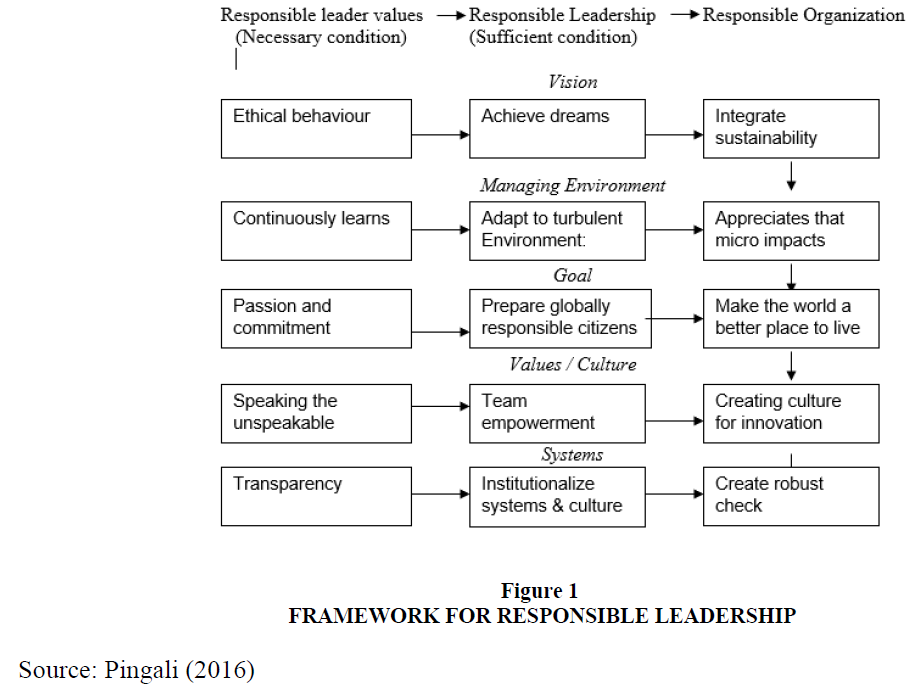Short communication: 2021 Vol: 13 Issue: 3
Management Curriculum: Integrating Circular Economy Using Responsible Leadership And Aol Frameworks
Pingali Venugopal, XLRI, Jamshedpur
Abstract
Keywords
Circular Economy, Sustainability, Management Curriculum, Responsible Leadership, AOL
Responsible Leadership Framework
Pingali (2016) developed a framework for Responsible Leadership with five levels (vision, managing environment, goals, values/ culture and systems) and each level having a necessary condition (responsible leader values) and a sufficient condition of the responsible leader to develop a responsible organization. The framework (figure 1) would help identify the areas that need to be developed to create managers with a mindset of building an organisation aligned to CE.
AASCB Assurance of Learning Goals Standards
Assurance of Learning (AoL) is a systematic process defining the learning outcomes of the students undergoing a programme. The AoL process encompasses five interrelated and iterative steps (AACSB, 2007). These steps are: (1) identifying the learning goals, (2) designing the courses to align to the learning goals, (3) defining the measures to assess learning, (4) imbibing the process and finally, (5) regular feedback and improvement (adopted from Lakhal and Serge, 2015). Several management schools across the globe have used AoL to define their learning goals. So, the AoL process could be used to define the programme goals and the learning goals aligned to CE.
Mapping AOL to Responsible Leadership framework.
The Responsible Leadership framework, which provides an integrated approach to building a responsible organisation, could determine the programme goal (under the AACSB Assurance of Learning Goals standards). The barriers and drivers of CE could be integrated to the different levels to identify the student learning goals for individual courses.
The suggested learning goals for different functional areas are described below. (It should be noted that the functional areas indicated for each level are only suggestive as the functional areas could cut across different levels).
1. Level 1 Vision (Strategy courses): “Political will” to ensure environmental wellbeing and overcoming inertia (no sense of urgency attitude) to help build an organisation in harmony with nature.
2. Level 2 Environment (Economics courses): Learn to face challenges and barriers due to market volatility, environment / policies not favouring CE, and build an organisation dedicated to reducing waste, eliminating use of toxic chemicals.
3. Level 3 Goals (Marketing / Finance courses): Ensure upfront investment costs, despite initial decreased sales, by focussing on a customer centric approach to educate; change attitude towards quality of recycled products to promote CE.
4. Level 4 Values (OB/HR courses): Collaborate with stakeholders to develop skills and expertise to balance linear and circular economy and encourage radical innovations to extend end of life of products.
5. Level 5 Systems (Finance / Production/ IT courses): Integrate between functions to overcome lack of data, develop a closed loop supply chain, and increase efficiency through better-cost and financial commitment.
Conclusion
Circular economy integrates economic growth and environmental protection. However, practitioners have not accepted CE. As education would play an important role in bringing about this change, this paper suggests that the management curriculum could be aligned to CE using the Responsible Leadership framework and the AACSB’s Assurance of Learning process to identify the programme goals and learning goals for different courses to build future ready CE managers.
References
- AACSB (2007), AACSB assurance of learning standards: an interpretation, Association to Advance Collegiate Schools of Business (AACSB) International, Florida https://naspaaaccreditation.files.wordpress.com/2014/04/aacsb.pdf, accessed April 18, 2019
- Lakhala Sawsen and Serge Sévigny (2015), “The AACSB Assurance of Learning process: An assessment of current practices within the perspective of the unified view of validity”, The International Journal of Management Education, Volume 13(1), pp 1-10
- Pingali Venugopal (2016), Responsible leadership: learning from Indian case studies, Asian Journal of Business Ethics 5 (1-2):139-147 (2016)
